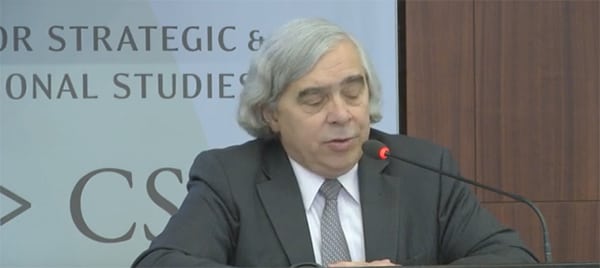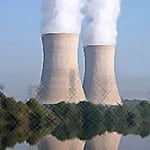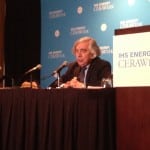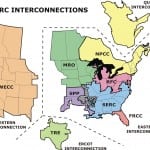Nuclear power’s future—and its much-needed contribution to U.S. decarbonization efforts—may be hampered if eight pressing issues aren’t addressed within the next five years, U.S. Energy Secretary Ernest Moniz said at a recent event held at the Center for Strategic and International Studies.
The issues Moniz outlined in his keynote speech at a six-hour event titled “Nuclear Energy at a Crossroads,” at the think-tank’s headquarters in Washington D.C. on October 24 include market concerns that have spurred the closure or announced retirement of several nuclear reactors, as well as the nation’s spent fuel management program being in limbo. Moniz also provided critical reasons for why nuclear power should be a pillar of the nation’s energy future, urging more public engagement, public funding, and public incentives to advance nuclear energy.
1. The fate of the existing U.S. nuclear fleet could have implications for carbon emissions. Over the last five years, low natural gas prices, market dynamics, technical issues, and policies that favor renewables have precipitated the closure or announced closure of 14 nuclear reactors. About half of the nation’s 99 reactors (which includes the commercial start of Watts Bar 2 and the closure of Fort Calhoun) are in competitive wholesale electricity markets. New York’s recently approved incentive program to help three nuclear plants remain economic over the next decade has been contested, Moniz noted, but it is an “innovative way” to preserve the plants that could be emulated by other states, like Illinois, he said. The closures also posed an “irony” in the context of the Clean Power Plan, Moniz said, because they will occur—assuming the environmental rule moves forward—when states begin submitting their implementation plans over the next five years. “Having their options narrowed is not exactly the way to approach that,” he said.
2. New reactors will come online over the next five years, but only in the Southeast. The closure of plants not in the Southeast and the construction of plants centered in the Southeast—in traditional markets that typically have vertically integrated utilities (see POWER‘s August 2016 BIG PICTURE infographic: “Nuclear Retirements“)—should “starkly” call attention to how different regulatory structures and cost recovery mechanisms are in the U.S., Moniz said. The Vogtle and V.C. Summer reactors are certain to generate “mixed reviews,” he remarked. However, what is important to the future of the nuclear sector is that the path forward will be “somewhat more clear” in terms of cost performance and schedule control for future new builds, he said.
3. The U.S. nuclear fleet is aging. More than 80 commercial reactors have garnered federal licenses to operate for 60 years, but 41 of these are more than 40 years old. “If nuclear plants retire, or at least, mostly retire, at around 60 years, then the big wave of retirements comes in around 2030. However, in the utility business, to replace that low-carbon power calls for capital allocation decisions, certainly on a decadal timescale. In other words, within the next five years, we’re going to have to see much more facing up to those large capital planning decisions,” Moniz said. To date, only two reactor owners are considering seeking licensing for 80 years of operation (Exelon for Peach Bottom Units 2 and 3, and Dominion for Surry Units 1 and 2). If other plant owners were able to extend lifetimes, it would be an “enormous deal” that could shift that 2030 date closer to mid-century closures, Moniz said. Yet, he noted that this would mean “some pretty big choices [need] to be made” over the next five years or so.
4. The need for a reliable, resilient, decarbonized electricity system is clear, but what it would look like is extremely unclear. Change is underway to set up a decarbonized electricity system, yet many questions remain open about the valuation of different services and characteristics of such a system. These could have tremendous implications for nuclear power, Moniz said. Questions include: “What is the value of fuel diversity? What is the value of baseload? What is the value of capacity? What is the value of storage? …,” he said. He added that the Department of Energy (DOE) is “well-along” on work for the second installment of the Quadrennial Energy Review, which includes defining these valuation questions.
Meanwhile, nuclear power could be essential in such a system, but that is not a “universally held view,” Moniz noted. “There is certainly a view that energy efficiency, combined with wind, combined with solar, combined with natural gas to balance those variable renewables at least in the nearer term, eventually heading into economical large-scale storage will be the system. No need for baseload,” he said. “Again, I’m not endorsing that, but that is a statement that is made quite regularly.”
Maintaining optionality is key: “Today, natural gas is growing so rapidly because it has low capital costs and low fuel costs. But I think building a system around a dominant role for natural gas going into the future is not an exercise in proper risk management in terms of the exposure to the unknowns of future fuel costs,” Moniz said. One issue is that the U.S. faces “highly distributed decision-making” within a fragmented regulatory regime.” Time is also an issue: It is clear that given the long time it takes to secure infrastructure investments, action should kick off over the next five to 10 years, he said.

5. Spent fuel management needs to get moving. “The situation that we have been in … for some time is a significant headwind for many decisions in the nuclear space, certainly in various states, with various utilities,” Moniz said. The DOE continues to settle with utilities with which it signed contracts in the early 1980s to transfer and store spent nuclear fuel waste to the now-defunct Yucca Mountain waste repository. On October 20, for example, Dairyland Power Cooperative secured a $73.5 million settlement for damages it incurred for storing spent nuclear fuel that the government should have removed from the utility’s long-closed La Crosse boiling water reactor in 1998. It was Dairyland’s second breach of contract lawsuit, covering damages incurred between 2007 and 2012. The company first sued the government in 2004 and was awarded $37.6 million in damages.
“Getting on with the job of moving spent nuclear fuel away from utilities is central,” Moniz said. “I continue to believe that consolidated storage, sometimes called interim storage, is absolutely essential, no matter when a geological repository is realized. Interim storage should be part of the system: It’s something on which, independent of geological repository issues, we can move on quickly.” Significantly, Moniz added that if Congress acted to give the DOE the authority, and whether or not it was a public or private effort, “we could [have] a pilot facility running in not much more than five years.”
6. A gap in the nuclear-fuel cycle and the proliferation arena. Moniz highlighted a number of developments that have called attention to these issues, including “continuing discussions” about reprocessing in Northeast Asia and the Iran deal. “The role of U.S. companies in global nuclear supply chains really is a very important pillar for what we do in the non-proliferation regime,” he said.
7. Assessing a future for small modular reactors (SMRs). The DOE expects the first SMR to go through federal licensing by the end of this decade and potentially be deployed within the following five years. “I think the key question, obviously, is understanding their cost performance parameters in the real world,” Moniz said. Also important is how SMRs would present opportunities for “different financing structures of nuclear reactors.”
8. Advanced nuclear technology needs a vast funding boost. While advanced nuclear technologies–such as molten salt, fast-neutron, and high-temperature gas reactors—generate a lot of interest, the future of advanced technologies is marred by a lack of federal government support. Moniz pointed to a September 22–released report from the Secretary of Energy Advisory Board, which was tasked with assessing what it would take to deploy one or more advanced nuclear technologies between 2030 and 2050. “Part of the answer in the end is that it would take at least half a billion dollars a year of federal support over an extended period for that to happen,” Moniz said. “And it’s a long time period, which means, if you want to get there by 2040, you start yesterday,” he said.
Moniz pointed out that federal energy research and development (R&D) efforts received a boost with the Obama administration’s commitment to Mission Innovation, an initiative signed by 20 countries, including the U.S., at the start of the Paris conference last November to double their clean energy R&D investments over the next five years. The DOE’s nuclear energy program has a $500 million to $600 million R&D budget today, Moniz said. “Well if we just notionally double that to $1.2 billion dollars a year, suddenly, a program that can include advanced reactor development in addition to life extension and SMRs and nuclear waste issues, suddenly it becomes possible,” he added. The measure has “strong” bipartisan support to do that, he said. “The trick is, obviously, to get that enthusiasm matched up with budget numbers.”
—Sonal Patel, associate editor (@POWERmagazine, @sonalcpatel)










